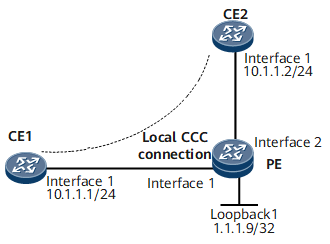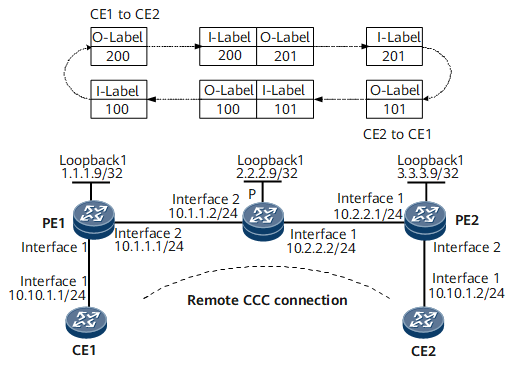VPWS in CCC Mode
CCC is short for circuit cross connect. A CCC is manually configured to implement L2VPN.
A CCC must be configured by network administrators and is best suited for small MPLS networks with simple topologies. CCC VPWS does not require signaling negotiation or exchange of control packets. Compared with other types of Layer 2 connections, CCC VPWS consumes relatively few resources and are easy to configure. However, CCC VPWS has poor scalability and is inconvenient to maintain.
Network Topology of VPWS in Local CCC Mode
A local CCC is a connection between two CEs connected to the same PE. Similar to a Layer 2 switch, a PE can directly complete switching without the need to configure a label switched path (LSP).
Figure 1 shows the topology in local CCC mode.

- Interface 1 and interface 2 in this example represent GE 0/1/0 and GE 0/1/0, respectively.

As shown in Figure 1, the CEs and PE are connected through GE interfaces. A local CCC connection is set up between CE1 and CE2. PE to which CE1 and CE2 are connected functions as a Layer 2 switch. Data of different link encapsulation types, such as VLAN and Ethernet, can be directly exchanged between the CEs.
The advantage of this mode is that no label signaling is required to transmit Layer 2 VPN information, and the ISP network merely needs to support MPLS forwarding.
Network Topology of VPWS in Remote CCC Mode
A remote CCC connection is set up between a local CE and a remote CE. Two CEs are connected to different PEs. Static CR-LSPs need to be configured to transmit packets from one PE to the other PE. A static CR-LSP must be configured on each PE to map to CCC connections.
Figure 2 shows the topology in remote CCC mode.

- Interfaces 1 and 2 in this example represent GE 0/1/0 and GE 0/1/0, respectively.

As shown in Figure 2, CE1 and CE2 are connected to different PEs. To allow the two CEs to communicate, create a remote CCC connection; configure two static CR-LSPs on the P to transmit packets in both directions.